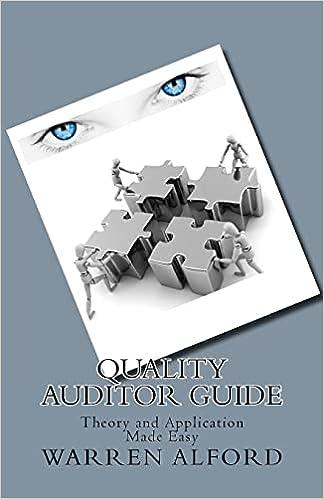Question
Can someone give me an example question regarding this review sheet BELOW: Your firm plans audit programs based on the following version of the audit
Can someone give me an example question regarding this review sheet BELOW:
Your firm plans audit programs based on the following version of the audit risk model:
AR = RMM x DR ,
The risk levels are MAXIMUM [that is, 100%], MODERATE, LOW, and VERY LOW. Assume that the audit risk AR is never greater than the risk associated with the lowest risk component [remember that low risk is good]. If the detection risk is low, then the audit risk cannot be greater than low. Nevertheless, even though control risk may be low, the auditor must still perform substantive tests [because GAAS requires substantive tests no matter how effective the controls are].
To reduce AR to LOW, both risk components on the right side of the audit risk model must be MODERATE or one must be LOW. To reduce AR to VERY LOW, at least one risk component must be VERY LOW, or one component must be no riskier than MODERATE and the other LOW.
DR for substantive tests of details with positive confirmations can never be greater than MODERATE.
If the auditor decides to perform tests of details with negative confirmations DR will always be MODERATE, regardless of the extent of testing
If the auditor decides to perform substantive analytical procedures, DR will always be MODERATE, regardless of the timing of the procedures.
THE PLANNED AUDIT PROGRAM
The audit manager has planned an audit program for testing the existence and valuation assertions of accounts receivable. Materiality is $1,000,000 and the planned AR is LOW. RMM is expected to be MODERATE. Planned DR is MODERATE.
The following are the only available options for testing. The audit managers choices are in boldface:
RISK: LOW MODERATE MODERATE
Nature of principal audit procedure: positive confirmation analytical procedure negative confirmation.
RISK: VERY LOW LOW MODERATE
Extent of principal audit procedure [confirmation]: 400 accounts 200 accounts 100 accounts.
RISK: VERY LOW LOW MODERATE
Timing of principal audit procedure: December 31 November 30 October 31.
NOTE: In dealing with the problem do not be concerned with attempting to combine the risk effects of nature, timing and extent. Nature, extent and timing will be dealt with separately and independently of each other.
Step by Step Solution
There are 3 Steps involved in it
Step: 1

Get Instant Access to Expert-Tailored Solutions
See step-by-step solutions with expert insights and AI powered tools for academic success
Step: 2

Step: 3

Ace Your Homework with AI
Get the answers you need in no time with our AI-driven, step-by-step assistance
Get Started


